Page 45 of 460

Seat and restraint systems
2-19
2
NOTE�If the seat belt subsequently remains unfastened, the
warning light and the tone will issue further warnings
each time the vehicle starts moving from a stop.
Front passenger seat belt warning light
N00418300237
The front passenger seat belt warning light is located at shown
in the illustration.
When the ignition switch is turned to the “ON” position or the
operation mode is put in ON, this indicator normally comes on
and goes off a few seconds later.
The light comes on when a person sits on the front passenger
seat but does not fasten the seat belt. It goes off when the seat
belt is subsequently fastened.
WA R N I N G
!�In order to reduce the risk of serious injury or death
in an accident, always fasten your own seat belt. Do
not allow anyone to ride in your vehicle unless he or
she is also seated and fastening a seat belt. Children
should additionally be restrained in a secure child
restraint system.
WA R N I N G
!�When a child booster seat is used on the front pas-
senger seat, the front passenger seat belt warning
light will not come on, if the seat belt is not fastened
when the booster seat is used. Confirm that the child
is wearing the seat belt properly.
BK0162600US.book 19 ページ 2013年3月22日 金曜日 午後2時41分
Page 48 of 460
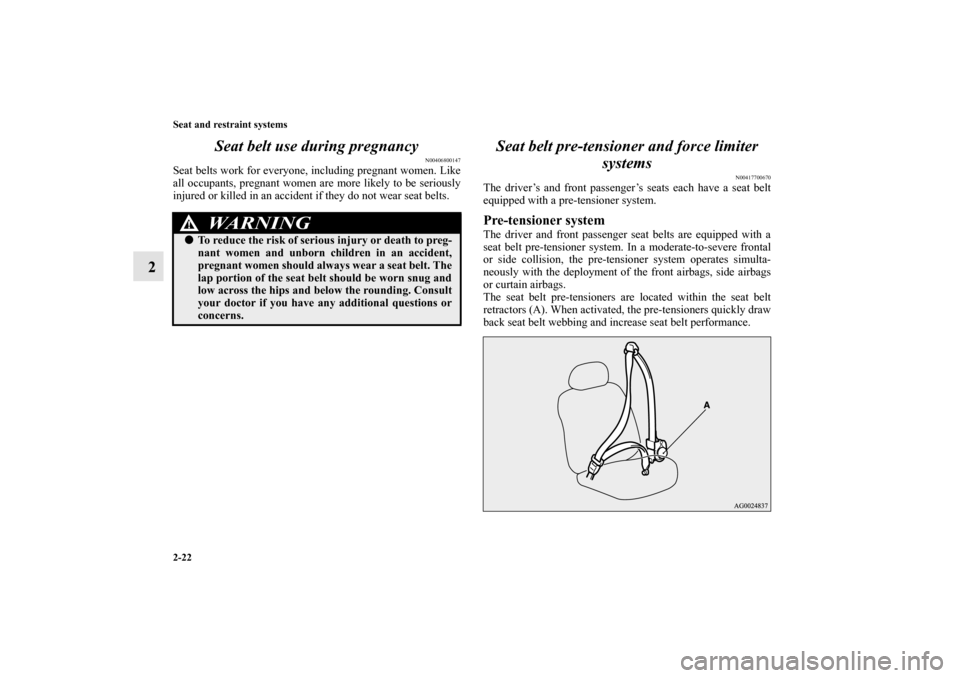
2-22 Seat and restraint systems
2Seat belt use during pregnancy
N00406800147
Seat belts work for everyone, including pregnant women. Like
all occupants, pregnant women are more likely to be seriously
injured or killed in an accident if they do not wear seat belts.
Seat belt pre-tensioner and force limiter
systems
N00417700670
The driver’s and front passenger’s seats each have a seat belt
equipped with a pre-tensioner system.Pre-tensioner systemThe driver and front passenger seat belts are equipped with a
seat belt pre-tensioner system. In a moderate-to-severe frontal
or side collision, the pre-tensioner system operates simulta-
neously with the deployment of the front airbags, side airbags
or curtain airbags.
The seat belt pre-tensioners are located within the seat belt
retractors (A). When activated, the pre-tensioners quickly draw
back seat belt webbing and increase seat belt performance.
WA R N I N G
!�To reduce the risk of serious injury or death to preg-
nant women and unborn children in an accident,
pregnant women should always wear a seat belt. The
lap portion of the seat belt should be worn snug and
low across the hips and below the rounding. Consult
your doctor if you have any additional questions or
concerns.
BK0162600US.book 22 ページ 2013年3月22日 金曜日 午後2時41分
Page 50 of 460
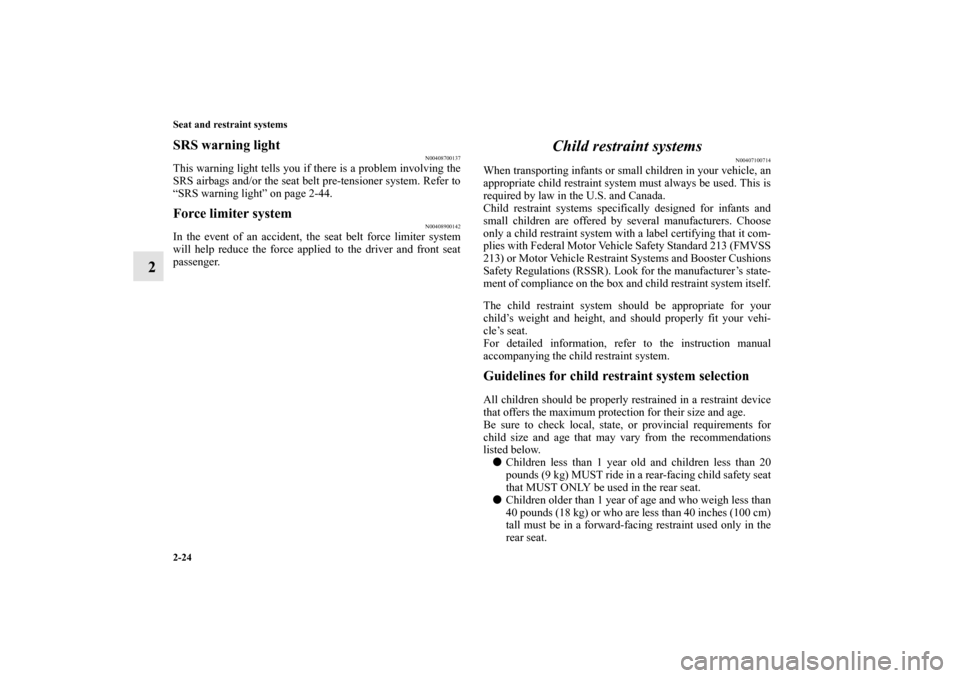
2-24 Seat and restraint systems
2
SRS warning light
N00408700137
This warning light tells you if there is a problem involving the
SRS airbags and/or the seat belt pre-tensioner system. Refer to
“SRS warning light” on page 2-44.Force limiter system
N00408900142
In the event of an accident, the seat belt force limiter system
will help reduce the force applied to the driver and front seat
passenger.
Child restraint systems
N00407100714
When transporting infants or small children in your vehicle, an
appropriate child restraint system must always be used. This is
required by law in the U.S. and Canada.
Child restraint systems specifically designed for infants and
small children are offered by several manufacturers. Choose
only a child restraint system with a label certifying that it com-
plies with Federal Motor Vehicle Safety Standard 213 (FMVSS
213) or Motor Vehicle Restraint Systems and Booster Cushions
Safety Regulations (RSSR). Look for the manufacturer’s state-
ment of compliance on the box and child restraint system itself.
The child restraint system should be appropriate for your
child’s weight and height, and should properly fit your vehi-
cle’s seat.
For detailed information, refer to the instruction manual
accompanying the child restraint system.Guidelines for child restraint system selectionAll children should be properly restrained in a restraint device
that offers the maximum protection for their size and age.
Be sure to check local, state, or provincial requirements for
child size and age that may vary from the recommendations
listed below.
�Children less than 1 year old and children less than 20
pounds (9 kg) MUST ride in a rear-facing child safety seat
that MUST ONLY be used in the rear seat.
�Children older than 1 year of age and who weigh less than
40 pounds (18 kg) or who are less than 40 inches (100 cm)
tall must be in a forward-facing restraint used only in the
rear seat.
BK0162600US.book 24 ページ 2013年3月22日 金曜日 午後2時41分
Page 51 of 460
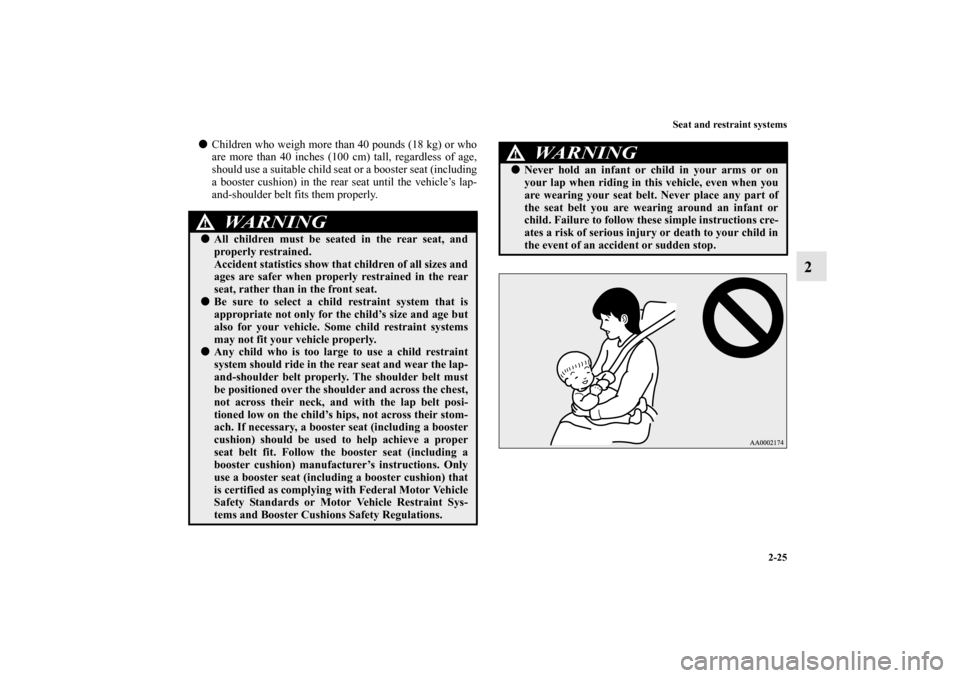
Seat and restraint systems
2-25
2
�Children who weigh more than 40 pounds (18 kg) or who
are more than 40 inches (100 cm) tall, regardless of age,
should use a suitable child seat or a booster seat (including
a booster cushion) in the rear seat until the vehicle’s lap-
and-shoulder belt fits them properly.
WA R N I N G
!�All children must be seated in the rear seat, and
properly restrained.
Accident statistics show that children of all sizes and
ages are safer when properly restrained in the rear
seat, rather than in the front seat.�Be sure to select a child restraint system that is
appropriate not only for the child’s size and age but
also for your vehicle. Some child restraint systems
may not fit your vehicle properly.�Any child who is too large to use a child restraint
system should ride in the rear seat and wear the lap-
and-shoulder belt properly. The shoulder belt must
be positioned over the shoulder and across the chest,
not across their neck, and with the lap belt posi-
tioned low on the child’s hips, not across their stom-
ach. If necessary, a booster seat (including a booster
cushion) should be used to help achieve a proper
seat belt fit. Follow the booster seat (including a
booster cushion) manufacturer’s instructions. Only
use a booster seat (including a booster cushion) that
is certified as complying with Federal Motor Vehicle
Safety Standards or Motor Vehicle Restraint Sys-
tems and Booster Cushions Safety Regulations.
WA R N I N G
!�Never hold an infant or child in your arms or on
your lap when riding in this vehicle, even when you
are wearing your seat belt. Never place any part of
the seat belt you are wearing around an infant or
child. Failure to follow these simple instructions cre-
ates a risk of serious injury or death to your child in
the event of an accident or sudden stop.
BK0162600US.book 25 ページ 2013年3月22日 金曜日 午後2時41分
Page 52 of 460
2-26 Seat and restraint systems
2
WA R N I N G
!�Your vehicle is also equipped with a front passenger
airbag.
Never put REAR-FACING CHILD RESTRAINT
SYSTEMS or INFANT RESTRAINT SYSTEMS in
the front passenger seat. This places the infant too
close to the passenger airbag. During deployment of
that airbag, the infant can be seriously injured or
killed. Rear-facing child restraint systems or infant
restraint systems must only be used in the rear seat.
Airbag
WA R N I N G
!�FRONT-FACING CHILD RESTRAINT SYS-
TEMS should be used in the rear seat whenever pos-
sible. If one must be used in the front passenger seat,
move the seat to the most rearward position and
make sure the child stays in the child restraint sys-
tem, properly restrained. Failure to follow these
instructions could result in serious injury or death to
the child.
BK0162600US.book 26 ページ 2013年3月22日 金曜日 午後2時41分
Page 53 of 460
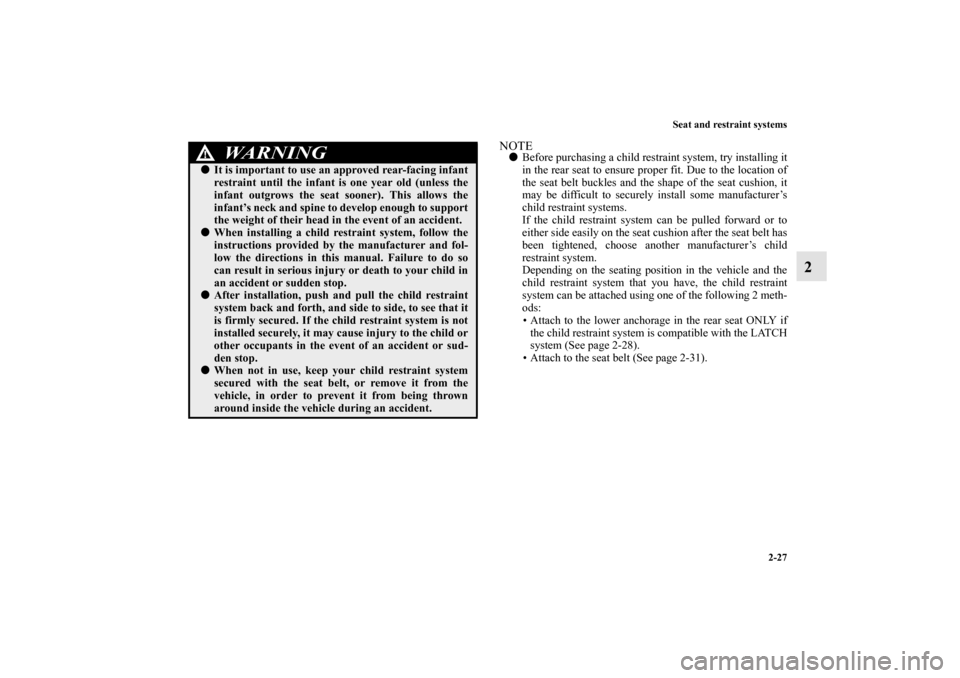
Seat and restraint systems
2-27
2
NOTE�Before purchasing a child restraint system, try installing it
in the rear seat to ensure proper fit. Due to the location of
the seat belt buckles and the shape of the seat cushion, it
may be difficult to securely install some manufacturer’s
child restraint systems.
If the child restraint system can be pulled forward or to
either side easily on the seat cushion after the seat belt has
been tightened, choose another manufacturer’s child
restraint system.
Depending on the seating position in the vehicle and the
child restraint system that you have, the child restraint
system can be attached using one of the following 2 meth-
ods:
• Attach to the lower anchorage in the rear seat ONLY if
the child restraint system is compatible with the LATCH
system (See page 2-28).
• Attach to the seat belt (See page 2-31).
WA R N I N G
!�It is important to use an approved rear-facing infant
restraint until the infant is one year old (unless the
infant outgrows the seat sooner). This allows the
infant’s neck and spine to develop enough to support
the weight of their head in the event of an accident.�When installing a child restraint system, follow the
instructions provided by the manufacturer and fol-
low the directions in this manual. Failure to do so
can result in serious injury or death to your child in
an accident or sudden stop.�After installation, push and pull the child restraint
system back and forth, and side to side, to see that it
is firmly secured. If the child restraint system is not
installed securely, it may cause injury to the child or
other occupants in the event of an accident or sud-
den stop.�When not in use, keep your child restraint system
secured with the seat belt, or remove it from the
vehicle, in order to prevent it from being thrown
around inside the vehicle during an accident.
BK0162600US.book 27 ページ 2013年3月22日 金曜日 午後2時41分
Page 54 of 460
2-28 Seat and restraint systems
2
Installing a child restraint system using the
LATCH (Lower Anchors and Tethers for chil-
dren) system
N00418800157
Lower anchor locationsThe outboard seating positions in the rear seat of your vehicle
are equipped with lower anchors for attaching child restraint
systems compatible with the LATCH system.
Tether anchor locations
N00418900190
Your vehicle has 3 attachment points on the back of the rear
seatbacks. These are for securing a child restraint system tether
strap to each of the 3 rear seating positions in your vehicle.NOTE�The attachments points are behind slits on the seatback
backboard cloth.
BK0162600US.book 28 ページ 2013年3月22日 金曜日 午後2時41分
Page 55 of 460
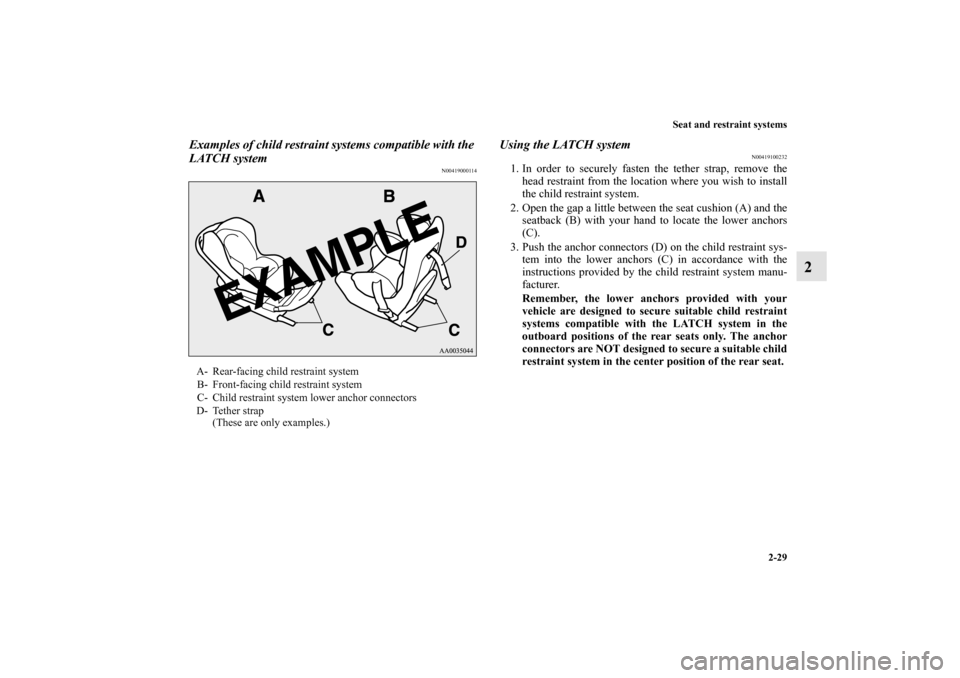
Seat and restraint systems
2-29
2
Examples of child restraint systems compatible with the
LATCH system
N00419000114
Using the LATCH system
N00419100232
1. In order to securely fasten the tether strap, remove the
head restraint from the location where you wish to install
the child restraint system.
2. Open the gap a little between the seat cushion (A) and the
seatback (B) with your hand to locate the lower anchors
(C).
3. Push the anchor connectors (D) on the child restraint sys-
tem into the lower anchors (C) in accordance with the
instructions provided by the child restraint system manu-
facturer.
Remember, the lower anchors provided with your
vehicle are designed to secure suitable child restraint
systems compatible with the LATCH system in the
outboard positions of the rear seats only. The anchor
connectors are NOT designed to secure a suitable child
restraint system in the center position of the rear seat.
A- Rear-facing child restraint system
B- Front-facing child restraint system
C- Child restraint system lower anchor connectors
D- Tether strap
(These are only examples.)
BK0162600US.book 29 ページ 2013年3月22日 金曜日 午後2時41分